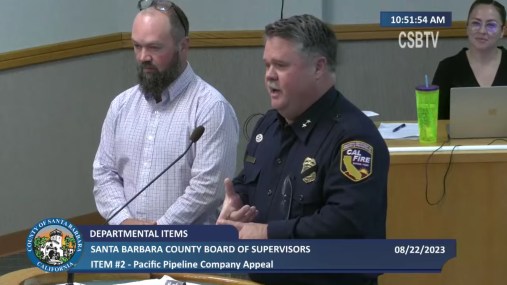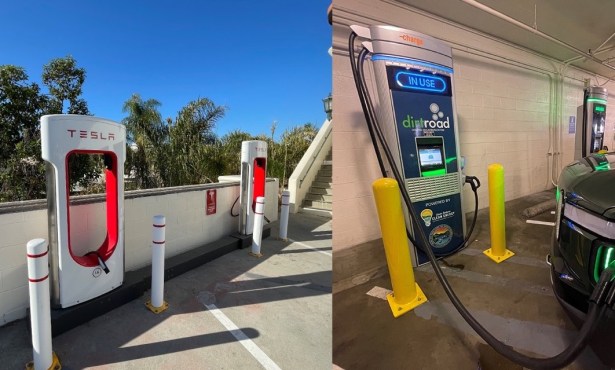ExxonMobil’s Refugio Pipeline Request Ends in Tie Vote
Santa Barbara County Board of Supervisors Deadlock 2:2

Requests to vote down Exxon’s attempt to add safety valves to its Line 901 — the pipeline that busted apart on May 19, 2015, spilling crude oil onto Refugio Beach and into the Pacific Ocean — came before the five Santa Barbara County supervisors from the usual anti-oil organizations, but also from unexpected groups like the Live Oak Unitarian Universalist Congregation of Goleta and the Santa Maria–Lompoc branch of the NAACP, as well as nearly 300 Santa Barbara County residents, who’d emailed letters that were largely boilerplate in their similar language.
Perhaps a dozen letters also came from supporters of the project, emphasizing that the Board of Supervisors had a duty to remain consistent with the permits and regulatory processes that Exxon had already invested in, because otherwise, what message did this send to businesses that also had to obey county rules?
When Supervisor Joan Hartmann recused herself from the vote, explaining that the pipeline runs “adjacent to the northeast corner of my property,” four supervisors remained — two representing the historically oil-patch North County and two from South County, which had suffered both the 1969 and 2015 oil spills. A tie vote was expected and was, indeed, the outcome. But not before some vehement rhetoric was heard, not just from the attorneys but from the many in attendance.

Everyone’s mode of transportation became a talking point after Supervisor Steve Lavagnino of Santa Maria challenged Barry Cappello, the attorney representing 133 landowners in litigation over pipeline access, to state how he got to the hearing today. Cappello finally admitted he had driven a car, but many of the 40 speakers who followed said they had arrived by electric vehicle or carpool or both.
The first to make a presentation, however, was Jim Hosler with the Office of the State Fire Marshal, which is the sole regulatory agency with jurisdiction over the pipeline’s safety and operation. Accompanying Hosler was Josh Cleaver, an attorney with the fire marshal’s office. Exxon hadn’t submitted a restart plan yet, and no application was guaranteed success, they said. And, while they believed safety valves were necessary to limit the volume spilled, they also said the pipeline operator could submit a restart plan using other criteria that might “prove they can operate the pipeline safely,” said Cleaver. Among those proofs was that the pipeline could hold liquid and “meet and pass additional safety measures before a restart, including that the best available technology has been applied,” said Hosler.
The term “best available technology” comes from Assembly Bill 864, which Supervisor Das Williams wrote after the Refugio spill when he was an assemblymember in 2015. His presence chairing the meeting did not go unexploited by Exxon’s attorney, Dawn Sestito, who mentioned no less than a half-dozen times that Willliams had written the very rule up on appeal today — the requirement for safety valves on pipelines in environmentally sensitive coastal areas.
Sestito echoed Hosler’s statements that with or without safety valves, the pipeline operator — ExxonMobil — could apply to restart the pipeline under other criteria that met the conditions established in a settlement agreement. Exxon’s appeal further argued that the question of safety valves was for the state fire marshal to decide, not the county; that the county could not use Coastal Zone rules in interior areas where the pipeline runs; that there were few to no visual impacts; and that a new environmental report was not required because the new valves spanned less than eight miles, which is a CEQA exception.

[Click to enlarge] A map showing the existing (yellow) and proposed (green) valves on the Las Flores Pipeline | Credit: Courtesy
Whether conditions had changed since the environmental report was approved in 1985 was a pivotal issue for both the Planning Commission and supervisors Williams and Laura Capps, who voted against the project. Conditions had indeed changed, speaker Larry Bishop indicated, who’d been a staffer on the county’s hazardous materials team before he retired. In fact, ExxonMobil knew in the 1970s that burning fossil fuels would cause worldwide climate damage, Bishop said. As has been well-documented, Exxon spent 27 years hiding the fact.
Speaker Julie Henszey urged the supervisors to think of the future for the planet, their children, other children, and not to believe Exxon when they said there was no danger here. “We are heading on a path we may not come back from unless you have the courage to take one step back in the right direction,” Henszey said.
Longtime climate activist Katie Davis spoke, reminding the supervisors that the changes included offshore platforms running 25 years past their shelf life. The county itself had argued during the Plains All American Pipeline criminal trial that the line should be abandoned and never restarted as a condition of parole, she said, only, the judge replied, there was no way to jail a corporation and enforce that provision.
“Exxon knew that pipeline was unsafe,” Davis asserted. “That’s why they applied to truck the oil, build a new pipeline, and have a new, other limited-liability blank-check company to actually run it … because they know it’s unsafe.”
As for the “blank check” company, Cappello had previously made the argument that Exxon fully intended to sell the company at a $2 billion loss to Sable Offshore Corporation. As well, Plains had paid more than a billion dollars to clean up after the oil spill and $236 million to fishermen and property owners for their losses, he stated, but Exxon was only guaranteeing the new operator — Pacific Pipeline Company, an Exxon subsidiary — $100 million. “That sounds like a lot of money,” Cappello said, flapping a white sheet back and forth. “But this is what it’s worth: a piece of paper.”
Williams asserted it wasn’t a certainty that Exxon would achieve a restart permit through the State Fire Marshal without shutoff valves. Like many attending the hearing, Williams drives an electric car, and he acknowledged that achieving the county’s emissions goal by adding 100,000 electric vehicles in the next six years was “intimidating.” They were clearly dealing with “changed circumstances,” he believed. “I cannot remove this decision from the context of the damage being made to the world — that is as clear as the color of the sky — nor the damage being made to our community.”
The 2:2 tie is essentially no action, said County Counsel Rachel Van Mullem at the end of the hearing. The Planning Commission’s denial of the project remains in place, and the ball is back in Exxon’s court as the company is allowed to reapply for the safety valves.




You must be logged in to post a comment.